Thesis Writing Documents
Thesis Writing
Thesis= the main idea of the essay.
What are you trying to prove?
a. fully address the prompt as many AP prompts will have more than one issue to be addressed; make sure you address all aspects of the prompt.
b. should be one or two sentences (semi-colons are your friend) located at the end of your introductory paragraph (after contextualization) then reword it in your conclusion (you can earn thesis point here if you miss it initially).
c. DO NOT SIMPLY RESTATE THE PROMPT
d. past tense
The thesis statement in AP US History uses the prompt to give direction and focus to the paper in question.
__________________________________________________
Introductory Paragraph:
Contextualization:
- 3+ sentences
-Describe a broader historical context relevant to the prompt
-Can be before, during (but not what you will argue in paper), or after the time frame
- Best bet/easiest option is to set up for the time period/ topic you will address in essay
Thesis: ( this is also the conclusion )
- 1 -2 sentences
-contains an argument
-contains 2-3 reasons
-No: I, we, me, you, us, our
-No: document citations at all (if you’re completing a DBQ (Document Based Question))
Body Paragraphs: you need 2-3 of these (depending on number of reasons/points in thesis)!
-Avoid vague statements/phrases (“many women,” “some Americans,” “things”)
-Avoid “never,” “always,” “obviously”
- 1-2 pieces of SFI (specific factual information) per body paragraph (evidence is KEY!)
- Make sure SFI is relevant to the prompt and is being used to prove your thesis
-First sentence of each body paragraph is a restatement of the thesis (a mini-thesis):
Mrs. Adams is an awesome teacher because not only does she give students feedback on their work, but she also provides multiple examples of good work and extra time for students to practice.
o First topic sentence:
Mrs. Adams is a great teacher because she provides feedback on student work, which typically results in higher grades on their report cards.
-The rest of this paragraph gives specific examples of when and how Mrs. Adams gives feedback, and makes an obvious connection to how this makes her a great teacher.
o Second topic sentence (transitioning from paragraph 2 to 3):
In addition to this helpful feedback, Mrs. Adams also provides samples of what A-worthy work looks like so students know what they should be striving for.
-The rest of this paragraph gives specific examples of when and how Mrs. Adams provides samples of what A-worthy work
looks like, and makes an obvious connection to how this makes her a great teacher.
o Third topic sentence (transitioning from paragraph 3 to 4):
Though it’s important to understand what A-quality looks like, a great teacher knows there must be ample time to practice the skills and interact with the content to create the understanding and knowledge that allows for exemplary products.
-The rest of this paragraph gives specific examples of when and how Mrs. Adams provides time for extra practice, and makes an obvious connection to how this makes her a great teacher.
Conclusion:
-Restates your thesis in different way ( not required, but you can earn the thesis point here if you left something out/did not fully address the prompt in your original thesis ).
Find what you need to study

How Can I Be Prepared for the AP US History FRQs?
5 min read • april 17, 2023
Sander Owens
👋 Worried about the FRQs on an upcoming APUSH exam or the actual AP exam? Don't worry! We're here to help you with a quick overview of what to expect on the Document-Based Question (DBQ) and the Long Essay Question (LEQ), as well as provide some advice from students who have done well on the APUSH exam.

Image Wikimedia Commons Writing the essays for AP US History takes an immense amount of practice and discipline.
APUSH FRQ Overview
The APUSH FRQ section consists of two essays: the DBQ and the LEQ. The DBQ is an essay in which you have to answer a given prompt using seven documents that interpret the historical event. The LEQ is an essay with a variety of prompts where you have to create an argument without any stimuli.
The biggest advice for doing well on the APUSH essays is planning. Take this student's advice:
"It was much faster to write once I had all of the information planned based on the rubric requirements" - Arthi
It may seem like a waste of time to plan out your essay when you have less than an hour to write, but it makes a difference! You can plan however you plan best: a mental outline, a bulleted list, a more fancy outline, or any other method that works for you.
DBQ Overview
The DBQ is the longer/more involved of the two essays for APUSH. You are given 60 minutes to write it, of which the first 15 are a planning/reading period.
You don't have a choice on the DBQ prompt, but it will only cover a topic from 1754 - 1980 (periods 3-8). The DBQ also includes seven documents that will interpret the events described in the prompt. The first step is to categorize those documents into 2-4 groups based on their common elements/views on the prompt.
You can increase your score just by knowing what to do. Simply writing a strong essay may not score as well if you don't know how to get all the points. Each one of these will score one point unless stated otherwise. Here's a quick, easy-to-read summary of the DBQ rubric:
👩⚖️ THESIS: Respond to the prompt with a claim about the prompt. Remember to take a stand on the prompt! An example of this might look like “Railroads supported empire-building by __________ and___________, BUT they undermined it by ________________." Use the categories you developed earlier to help fill in the blanks in your thesis!
🌎 CONTEXTUALIZATION: Describes the broader historical context relevant to the prompt. Think of what happened in the years/centuries leading up to the prompt (big events like global wars, trends, patterns, etc). You MUST connect this to the prompt.
🔍 EVIDENCE FROM THE DOCUMENTS: Use evidence from the docs to prove your point. Do not quote! Just use what the docs are saying to support your argument and cite them like this (2). Using evidence from 3 docs will score in 1 point while using evidence from 6 docs will score 2 points.
🚴♀️ OUTSIDE EVIDENCE: Consider people, places, events, and concepts that are NOT discussed anywhere in the documents and connect them to your argument.
🦛 SOURCING/HIPP: For at least 3 documents, you must explain how or why the broader historical context, intended audience, purpose, or point-of-view of a document is relevant to your argument. Use the acronym HIPP to remember this!!
🦄 COMPLEXITY: Demonstrates a deeper understanding of the prompt. You should weave a counter-argument throughout your essay. Don't stress too much about this one! It is pretty hard to get, and it's not something you can really try to add.
One of the easiest ways to get all of these points is to write it all down in a checklist next to your planning and tick them off as you go through.
"When I write essays, I like to have a checklist with me so I can keep count of what points I am confident I have earned" - Anna
Here's an outline that will help you write a concise, great essay!
👋 INTRO: 3-4 sentences of context to explain background information and relate it directly to the topic of the prompt. 1-2 sentence thesis statement that restates prompt + provides an argument.
👕 BODY PARAGRAPHS (INCLUDE AS MANY AS YOU HAVE CATEGORIES): Add a topic sentence to introduce your argument. Explain a piece of evidence from a document to back you up and connect that evidence directly to your argument. Source the document (HIPP)—choose Historical Context, Intended Audience, Purpose, or POV. Then, include a piece of evidence not mentioned anywhere in the documents and explain this outside evidence to strengthen your essay.
🧐 CONCLUSION: Sum up your argument with a counterargument, and rephrase your thesis. You can earn the thesis point here if it wasn't strong enough in the intro.

Image Wikimedia Commons Hopefully this guide can serve as your map to success!
LEQ Overview
The LEQ is the shorter of the two essays—you only have 45 minutes to write it. However, you have a choice between three prompts based on the periods: 1491 - 1800, 1800 - 1898, and 1898 - 2001. All three prompts will be about similar themes, so pick the one you can write about the most!
Like the DBQ, knowing the rubric is crucial! Each one of these will score one point unless stated otherwise.
🔍 EVIDENCE (x2): Provide specific historical examples to support your argument. These are specific people, places, and events. Explain your terms, and then connect it to your argument.
📚 HISTORICAL REASONING: Use comparison, causation, or CCOT to answer the prompt. You can answer the prompt using any skill, but choose one and stick to it!
Helpful Links
📰 Our Ultimate Guide to the DBQ!
📺 Replay of a Live LEQ Scoring stream with someone who has been an AP Reader!
📝 Replay of a DBQ Skills Stream!
🌶️ Complete Review of APUSH Content with Possible Essay Topics by Period!
A Word of Encouragement...
Throughout your review, remember these simple words: you will do fantastic! If you're reading this guide, it means you are taking steps to prepare for your exam. By following some of the advice we have given, you will become a much better writer and allow you to nail those essays!
You got this! 🎉

Stay Connected
© 2024 Fiveable Inc. All rights reserved.
AP® and SAT® are trademarks registered by the College Board, which is not affiliated with, and does not endorse this website.
APUSH Free Response Questions and Responses: A Study Guide
The Free Response Question (FRQ) is a tried-and-true component of the APUSH exam. The FRQ is basically a fancy way of saying an essay. But, as I’m sure you have uncovered, there’s a lot of different types of essays on the APUSH exam. Refer to the table below about the differences between the essay types.
For this blog post, I will take you through the steps of answering a Long Essay Question (LEQ) for the APUSH exam, including given you student responses to analyze. At the end of this blog post, I will give you a new question for you to try on your own (and you should – doing well on the APUSH exam will require lots of practice!). All of the material in this blog post will come from the College Board website, and I strongly suggest you create your own student account to get more material.
Alright, let’s go!
Free Response Questions: LEQ #1
This LEQ comes from the 2016 APUSH exam that you can find on the College Board website. Please read the question below:
Evaluate the extent to which United States participation in the First World War (1917–1918) marked a turning point in the nation’s role in world affairs. In the development of your argument, explain what changed and what stayed the same from the period immediately before the war to the period immediately following it. (Historical thinking skill: Periodization).
Maximum Possible Points: 6
Please note:
- Each point of the rubric is earned independently, e.g., a student could earn the point for synthesis without earning the point for thesis.
- Unique evidence from the student response is required to earn each point, e.g., evidence in the student response that qualifies for either of the targeted skill points could not be used to earn the point for thesis.
Before you start writing, it will be INCREDIBLY IMPORTANT for you to organize your thoughts. Follow these three steps to organize your thoughts for the LEQ.
1. Understand what the question is asking you to do. 2. Make a table about what information is and is not relevant. 3. Develop your outline. Start with your thesis.
Below, I will take you through each step.
Understand what the question is asking you to do
Not every question is going to ask you to do the same thing. Some questions will ask you to compare and contrast events, and others will have you identify change and continuities over time. For this question, you are asked to evaluate the role of the U.S. in World War I and the extent to which this represented a turning point in the post-WWI world. Three words should stick out to you here:
1. Evaluate; 2. Extent; and 3. Turning point.
(Yes, that’s technically four words. I know.)
If I were to translate this into plain speech, I would come up with the following:
How much (if at all) did the U.S. involvement in WWI represent a turning point in how the nation operated in global affairs? Explain with evidence.
It’s only when you can put the question in your own words that you can go about answering it at a high level.
Make a table about what information is and is not relevant
A table is a useful way for you to brainstorm information quickly and efficiently. I suggest creating two categories in your table because not everything you think up will be relevant to answering the question. Take a look at the table I have created below and see if you can identify which information is relevant and which information is not.
Can you identify what ideas would be useful to answer this question and which would not?
If you thought “women’s suffrage”, “Weimar Republic”, and “the Great Migration” wouldn’t be helpful, you were right. The question is asking about the United States involvement in global affairs after WWI. Women’s suffrage involves the US, and the 19th amendment passed after WWI, but it doesn’t deal with global affairs; the Weimar Republic is the post-WWI world, but doesn’t really affect the US in the way the question is asking; finally, the Great Migration hits the U.S. criteria, but isn’t really about global affairs.
Develop your outline. Start with your thesis.
After you have developed a list of ideas that are relevant to helping you answer the question, come up with your outline but always start with your thesis . Remember that your thesis is a direct answer to the question. In this instance, you need to answer how much the US involvement in WWI represented a turning point for the nation in global affairs.
What does the evidence you generated tell you?
However you decide to answer the question, make sure that your evidence matches the conclusion you reach.
Another useful way to organize your outline is based on the scoring rubric. You will be assessed on the following:
A. Thesis (1 point) B. Argument Development: Using the Targeted Historical Thinking Skill (2 points) C. Argument Development: Using Evidence (2 points) D. Synthesis (1 point)
In the next section, I will explain what the APUSH exam is looking for in a thesis statement. I strongly suggest that you look at all of the content that the College Board provides in their expanded version of scoring notes. You will need to create an account to access this, but trust me: it’s worth it.
Free Response Question (LEQ #1): Breaking Down the Scoring Rubric
In this section, I will explain what the APUSH scorers are looking at for each section. Remember, all of this information is available via the College Board website.
According to the College Board, the APUSH exam scoring notes state, “the thesis does not need to be a single sentence, it does need to be discrete, meaning it cannot be pieced together from across multiple places within the essay. It can be located in either the introduction or the conclusion, but not split between the two.”
Reference the table below for two examples of acceptable thesis statements.
If you noticed, the two thesis statements above opposite perspectives and yet, they both received full credit. It does not matter what side you come down on in answering the question, as long as you are clear and have evidence.
Notice the difference between the above thesis statements and the below thesis statement:
The United States has always been a powerhouse country. The American economy has been strong (despite a couple of bumps) and the people even stronger. The First World War showed the true power of the United States due to the willingness of its citizens and the brightness of their minds.
This thesis statement does not answer the question clearly, and, as such, it did not receive a point.
Free Response Question #2: Putting it all together
Now it’s your turn! This sample question is also from the 2016 APUSH exam. Once you have followed the steps I provided above (Understand what the question is asking you to do, 2. Make a table about what information is and is not relevant, and 3. Develop your outline. Start with your thesis!! ), you should check your response against the scoring notes provided for the question and read other student work. Good luck!
———————————————————————————————————–
Evaluate the extent to which the ratification of the Fourteenth and Fifteenth Amendments to the Constitution marked a turning point in the history of United States politics and society. In the development of your argument, explain what changed and what stayed the same from the period immediately before the amendments to the period immediately following them. (Historical thinking skill: Periodization)

Allena Berry loves history; that should be known upfront. She loves it so much that she not only taught high school history and psychology after receiving her Master’s degree at Stanford University, she is now studying how students learn history at Northwestern. That being said, she does not have a favorite historical time period (so don’t bother asking). In addition to history, she enjoys writing, practicing yoga, and scouring Craigslist for her next DIY project or midcentury modern piece of furniture.
View all posts
More from Magoosh
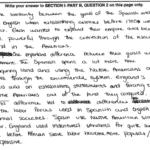
Leave a Reply Cancel reply
Your email address will not be published. Required fields are marked *

Choose Your Test
Sat / act prep online guides and tips, the ultimate apush dbq guide: rubric, examples, and more.
Advanced Placement (AP)

You’ve been working hard in your AP US History class, and now it’s time to start prepping for your APUSH exam.
But there’s a lot you’ll need to know if you want to do well, especially on the APUSH DBQ section. For instance, you’ll need to understand the APUSH DBQ rubric so you know how you’ll be scored on your answers, and you’ll need to look at a few APUSH DBQ examples so you understand what it takes to
Luckily for you, we’ve compiled everything you need to know about APUSH DBQs in one easy place. (That place is, uh, here. ) We’ll go over:
- An explanation of what APUSH DBQs are and why they’re important
- A walkthrough covering how APUSH DBQs work on the exam and what to expect
- A six-step process for writing a great DBQ
- Four tips for studying for and answering the APUSH DBQs
We’ll also give you an APUSH DBQ rubric and APUSH DBQ examples That’s a lot to talk about, so let’s get going!

The APUSH DBQ is an essay-based question, so you'll have to write quickly!
What Is an APUSH DBQ?
A DBQ is a “document-based” question that you’ll have to answer on your AP exam. For these questions, you’ll be given seven “documents,” which are short readings that cover different, usually related aspects of US History. From there, you’ll be asked to answer each DBQ in essay form using information from the documents you’ve been provided!
The good thing about APUSH DBQs is that they’re open-ended, meaning there are multiple correct ways to answer each question. The downside is that in order to answer the question and earn full credit, you’ll need to analyze and incorporate multiple documents as part of your argument.
And did we mention you’ll only have a limited amount of time to answer the DBQ, and that it's worth 25% of your total test score? That’s why APUSH DBQs can be stressful for test-takers!
How Do DBQs Work on the APUSH Exam?
The APUSH exam consists of 60 questions in total. Here’s how they break down across the test:
Of the two free response questions, one is a long essay (worth 15%) and one is a DBQ. This means that the sole DBQ is, by itself, worth 25% of your total grade, making it the single most heavily-weighted question on the APUSH exam.
The APUSH DBQ will consist of a single open-ended prompt . To answer it, you’ll have to create a persuasive argument that uses the documents you’ve been given on the exam itself. (More on that a bit later.)
To give you a little more context, here are some actual APUSH DBQ examples from previous years’ APUSH exams:
- “Evaluate the extent of change in ideas about American independence from 1763 to 1783.” ( 2017 )
- “Evaluate the relative importance of different causes for the expanding role of the United States in the world in the period from 1865 to 1910.” ( 2018 )
- “Evaluate the extent to which the Progressive movement fostered political change in the United States from 1890 to 1920.” ( 2019 )
APUSH Document Types
To answer these questions well, you’ll also have to read, analyze, and incorporate information from seven documents you’ll be provided on test day. These documents will be a mixture of:
- Primary texts : texts that were actually written in the time period you’re being asked about
- Secondary texts : texts written by later historians that explain the time period
- Images: these are typically either political cartoons or artworks from the time period
How many of each type of document you’ll see on your exam varies from year to year, so you’ll need to be equally comfortable using all three types of documents.
You’ll have to read through all seven documents and understand them so you can use them to answer your DBQ question. The information in the documents will help you create a thesis, build your argument, and prove your point…so you can get a great APUSH DBQ score! Just remember: to earn full credit, you’ll also have to explain how at least six of the documents are relevant to your argument, using evidence to back those claims up.
Using Outside Information
Along with the provided documents, you’ll also be expected to use one piece of historical evidence that isn’t included in the documents , but you already know from your own reading. This is information that you’ll have studied in class (or read on your own!) that applies to the DBQ and supports your argument.
Unfortunately, you won’t be able to bring any class notes with you on exam day. That means you’ll need to study ahead of time so you’ll be ready to incorporate outside information into your DBQ answer!
Whew! That’s a lot! However, if it makes it any easier, the APUSH DBQ will only cover the period from 1754-1980 . That means you’ll only need to focus on studying–and remembering!--information from about 230 years.

Understand the APUSH DBQ Rubric
First, you need to understand what the expectations are and how your answer will be graded. That means reading through and understanding the official APUSH DBQ rubric!
The good news is that the College Board has provided the APUSH DBQ rubric as part of their 2021 AP Exam Administration Scoring Guidelines - AP United States History document .
Here’s how the rubric breaks down:
Thesis (1 point)
First, you’ll need to create a thesis that “responds to the prompt with a historically defensible thesis/claim that establishes a line of reasoning.” In order to get this point you’ll need to make an arguable claim based on the documents that answers the question of the prompt.
In other words, you’ll need to choose a position and then defend it with evidence from the documents and your knowledge base.
Contextualization (1 point)
In order to get a point for contextualization you’ll need to “accurately describe a context relevant” to the time period covered by the prompt. What this means is that you’ll have to describe the political, social, or economic events and trends that contributed to what your thesis is arguing.
Some of this you’ll know from the provided documents, but some of it you will also be expected to know on your own based on what you’ve studied in AP US History. You’ll also need to relate your knowledge to “broader historical events, developments, or processes that occur before, during, or continue after the time frame of the question.” That means you have to show how the events of this time period are relevant now or how they are similar to some other historical situation .
Evidence (3 points)
For this part of the rubric, you’ll earn one point just for incorporating specific evidence that does not come from the provided documents in a way that is relevant to your thesis!
In order to earn the other two points, you must support your argument by using content from six of the seven documents . (If you don’t use six documents, but do use at least three of them, you’ll only earn one point.)
You can’t just randomly throw information from the documents into your essay, though, you have to use it in a way that supports your argument and accurately represents what the documents are saying .
Analysis and Reasoning (2 points)
For the analysis and reasoning section, you get one point for explaining “how or why the document’s point of view, purpose, historical situation, and/or audience is relevant to an argument.” You’ll earn another point for “complexity,” showing that you understand the time period that the prompt covers and use evidence to prove your understanding and back up your argument .
So to earn analysis and reasoning points, you have to prove how the documents are relevant to your argument, your argument has to demonstrate you understand the historical events of the time period, and you’ll have to create an argument that is well-reasoned and “complex.”
You’ll need to show graders you understand there’s a variety of possible perspectives about the issue you’re writing about and that people in that era did not all agree or have the same experiences.
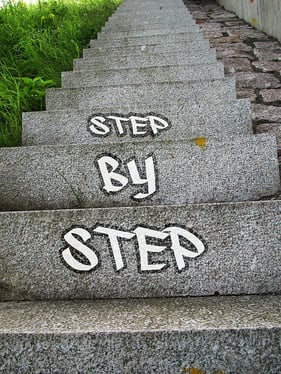
Step-By-Step Process for Tackling an APUSH DBQ
The APUSH DBQ is a complicated question that tests you over several different skills, so there isn’t any simple technique to ace it. However, if you master each of the individual skills it takes to do well on the DBQ examples, rocking your APUSH DBQ will be much easier!
Here are five steps you can follow to build a foundation that’ll help you ace the DBQ.
Step 1: Take a Practice DBQ
The best way to master APUSH DBQs is by practicing with real APUSH DBQ examples.
The College Board’s website has the actual prompts from 2015-2019 available to download. This means you can take at least five practice APUSH exams, as well as read APUSH DBQ example responses and APUSH DBQ rubrics, for free!
This is excellent news because you can take several practice swings at answering APUSH DBQs before you have to tackle the real thing on test day.
Before practicing DBQ responses, it’s a good idea to take at least one APUSH DBQ practice test so you know what your baseline is. That way, you’ll understand your strengths and weaknesses and can really zero in on your weakest areas! From there, you can work through the practice APUSH DBQ prompts on their own.
However, the nature of a free response means that it won’t be easy for you to grade by yourself. To evaluate your DBQs, be sure to use the APUSH DBQ rubric we walked through above. Honestly try to assess whether or not you incorporated the information thoroughly and accurately. You can also ask a teacher, tutor, or even a family member to grade your APUSH DBQs for you as well!
Later, after you practice the skills outlined in the steps below, take another practice DBQ and see if it seems easier for you. Compare your score to the baseline score from your first attempt. Then, re-read over your textbooks and take it again. Repeat the cycle a couple of times. The big benefit will be that you will eventually get so used to the APUSH DBQ that you will be more comfortable in the actual testing environment .
Step 2: Practice Writing a Thesis
Because your DBQ response will have to choose a position and defend it, you’ll need to work on writing strong thesis statements. A thesis statement is essentially your argument in a nutshell, and it sums up the purpose of your essay.
The most important aspect of your APUSH DBQ thesis is that it has to make a claim that is both arguable (meaning you can use evidence to prove it) and is relevant to the prompt you’re given. However, you don’t want to just restate the prompt in your thesis!
Here’s what we mean. Let’s say your APUSH DBQ prompt is:
Evaluate the extent of change in ideas about American independence from 1763 to 1783.
You don’t want your thesis to be “Ideas about American independence changed a lot from 1763 to 1783. That’s just adding a few words to the prompt…and it’s not descriptive enough to cover the argument you’ll make later. Instead, make a specific claim about how and why ideas about American independence changed, and you’ll need to use the documents provided to prove it!
So for this example, a better thesis might be, “Between 1763 and 1783, American ideas about independence changed from being unsure about how the nation could survive without British rule to believing in (and fighting for) the nation’s independence.”
Because APUSH DBQs are open-ended, there are actually many different thesis statements you could come up with that would let you write an amazing answer. Here are two APUSH DBQ examples that College Board considers acceptable theses for this prompt:
- “The ideas about American independence changed greatly from 1763 to 1783. In the beginning, colonists only wanted representation and a say in the legislation of new laws, but by 1783 Americans wanted true freedom from British rule.”
- “From 1763–1783, ideas of American independence changed from the colonies blindly accepting the tyranny of the British by religious rights of divine kings to believing in natural rights of individuals against British rule.”
Let’s look at how these theses make specific claims:
The first thesis argues that colonists originally only wanted representation, but by 1783 wanted freedom from British rule. These are two different mindsets that the author can then use the documents to illustrate and prove actually existed.
The second example thesis addresses a more theoretical change in belief: one that changes from Americans of 1763 accepting the medieval notion of the king inheriting from God the right to govern, to one in which Americans of 1783 believed that individuals had the natural right of freedom from tyranny. The author can then use the documents as evidence that Americans in that time period had those beliefs, and can argue about what happened to change them.
By practicing thesis writing, you’ll be able to create a detailed–and defensible!--statement that will help you create a convincing DBQ argument.

An outline will serve as a roadmap that'll help you write a great essay—and it'll help you manage your time, too.
Step 3: Practice Creating an Outline
With only an hour to read the documents to write your essay, you probably won’t have time to revise. It’s very important that you make the best use of the limited time you will have available, so an outline will help you organize your thoughts and will keep you on track as you write.
Just be careful that you don’t take too much time with your outline–you need to write a whole essay! Five minutes (or less!) is all you need to put together an outline that’ll help you write an awesome DBQ.
With that said, let’s talk about what makes up a great outline.
Two important elements of a good outline are an introduction and conclusion ! Your intro will set up your thesis and your conclusion to restate your thesis while explaining why it’s relevant to the reader today. Because both of these sections center around your thesis statement, they’ll help you organize the rest of your argument…and your DBQ essay!
Once you have those in place, you can start adding body paragraphs to your outline. Since you only have about 45 minutes to write this essay, you don’t want too many of them. Three or four body paragraphs will be enough to get the job done.
The most important thing about your body paragraphs is that each of them makes a claim that a) supports your thesis and b) allows you to incorporate information from the documents as evidence. You may even want to make a note of which documents you want to use in each body paragraph!
Here’s an outline template you can use as you practice your APUSH DBQs:
- Set up your argument and include your thesis.
- You can break down your thesis into several component steps, which will then become the body paragraphs as you expand upon them.
- Tell the reader what they need to know about the historical situation.
- Include any information you might already know from outside the provided documents.
- Make the first argumentative point you mentioned in your introduction/thesis.
- Use information from two to three documents to illustrate and prove your point.
- Make the second argumentative point you mentioned in your introduction/thesis.
- Use two to three different documents to support this point.
- If you have a third argumentative point, you’ll need to make it here.
- Be sure to use at least one document to support your argumentative point.
- Restate your thesis and summarize the main points you’ve made.
- Show how it’s relevant to the reader.
Again, this outline doesn’t need to be fancy! Jotting down a few words–or a short sentence–for each point will get you to where you need to go.
Step 4: Practice Incorporating Quotes and References
As you write your essay, you’ll need to use examples from the documents provided–and each time you do so, you need to explain documents you pulled the information from. You’ll do this whether you are quoting your source or just paraphrasing it.
There are two ways to do this:
#1: Attribution
Attributing your information means you tell your reader in the sentence which document you’re quoting or paraphrasing from. Below are two attribution DBQ examples APUSH considers acceptable:
"Charles Inglis uses reason to note that the colonies would be unable to sustain themselves without British support because the colonies don’t make enough money through agriculture and commerce.”
Notice that even though this APUSH DBQ example doesn’t quote Inglis outright, the author still lets the readers know which source they’re using to prove their point.
#2: Parenthetical
Using a parenthetical citation means that you put either the author of the source’s name or which document it’s from, in parentheses, at the end of the sentence. H ere’s an example of parenthetical citation that the College Board considers acceptable:
“He claimed only man himself can direct his own actions and decisions, not the rule of any legislative authority or man (Doc. 3).”
Since the sentence does not say who “he” is, the author of this essay has included this parenthetical citation (Doc. 3) that the reader can use to read the document in question and see if the argument the author is making is correctly represented from the source.
As you use these sources, you need to make sure that you are using the document accurately and not plagiarizing. Your goal is to show that you understand each document and know how to incorporate it into an argument.
Step 5: Understand Time Management
One of the most important skills you can acquire by taking multiple attempts at the APUSH DBQ practice test will be time management . When you’re in the actual test environment, you won’t be able to use your phone to set a timer or alarm, so it can be difficult to keep track of how much time you’re spending on reading and re-reading the documents, brainstorming, and outlining.
You want to leave yourself the majority of the time allowed (which will be one hour) for writing. College Board’s APUSH DBQ rubric recommends that you spend 15 minutes reading the documents and 45 minutes writing the essay .
The best way to get your time management down is practice . Set timers during your APUSH DBQ practice test so you can get a feel for how much time it takes to put an answer together. That way you have a feel for the process and will have enough time to write your DBQ on test day.
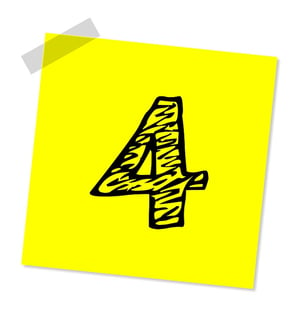
4 Tips for Mastering APUSH DBQs
Now that you’ve read our step-by-step process for tackling the APUSH DBQ and have seen several APUSH DBQ examples, here are some expert tips on doing well on the APUSH DBQ .
Tip 1: Remember that Each Point Is Scored Separately
Go through the APUSH DBQ rubric and take note of each individual task since you’ll be scored on how well you complete each one . For each task, there are usually multiple points available.
For example, you’ll earn one point for using at least three documents in your DBQ. But if you want to earn the full two points for that category, you’ll need to incorporate at least six documents into your answer.
By understanding the rubric, you’ll be able to maximize how many points you earn on your DBQ.
Tip 2: Your Essay Can Contain Errors
Now, don’t misunderstand us: you can’t say an author makes one claim when they are clearly saying the opposite. You also can’t write something that is obviously wrong, like that America continues under British rule because the revolution was unsuccessful, and get full credit!
But you can make minor errors that don’t detract from your argument as long as you are demonstrating a knowledge of the time period and the ability to incorporate evidence to make an argument. So for example, if you said that the First Continental Congress ended in November instead of October of 1774, you’ll still be able to earn full credit despite making a small error.
Tip 3: Write For Clarity
One thing to keep in mind is that you will be graded on how well you make and argue a thesis, and how well you incorporate the evidence from the documents to support that thesis– you don’t get graded on how beautifully or fluently you write ! So, while you’ll want to use correct grammar and write as clearly as you can, don’t spend too much time thinking about how best to phrase things as if you were writing for publication. Just focus on clearly explaining your ideas!
You won’t have points taken away for grammatical errors unless they make it difficult for the graders to see how you’ve used the evidence to make an argument.
Tip 4: Connect the Dots
Not only for the APUSH DBQ, but for everything you write, you need to ask yourself, why is this relevant? In the contextualization section, you are required to relate the information you’re conveying to other time periods or situations to earn full credit.
This is your chance to show that while the period you’re writing about may have been long in the past, the events are still relevant to us today ! This is why we read, write, and study history in the first place!


What’s Next?
If you’re taking APUSH, you’re probably taking other AP classes as well! Here’s a general guide to preparing for AP tests that’ll help you get ready for any other AP exams you take.
Like we mentioned earlier, taking practice tests is one of the best ways you can get ready for your actual AP exams. Here’s a guide that’ll help you find the best AP practice tests for each exam.
If you’re taking multiple AP tests, you’ll need to maximize your study time. One way to do this is to study for each test based on when you’ll have to take it! Our complete breakdown of the AP exam schedule will help you manage your study time efficiently and effectively.

Ashley Sufflé Robinson has a Ph.D. in 19th Century English Literature. As a content writer for PrepScholar, Ashley is passionate about giving college-bound students the in-depth information they need to get into the school of their dreams.
Ask a Question Below
Have any questions about this article or other topics? Ask below and we'll reply!
Improve With Our Famous Guides
- For All Students
The 5 Strategies You Must Be Using to Improve 160+ SAT Points
How to Get a Perfect 1600, by a Perfect Scorer
Series: How to Get 800 on Each SAT Section:
Score 800 on SAT Math
Score 800 on SAT Reading
Score 800 on SAT Writing
Series: How to Get to 600 on Each SAT Section:
Score 600 on SAT Math
Score 600 on SAT Reading
Score 600 on SAT Writing
Free Complete Official SAT Practice Tests
What SAT Target Score Should You Be Aiming For?
15 Strategies to Improve Your SAT Essay
The 5 Strategies You Must Be Using to Improve 4+ ACT Points
How to Get a Perfect 36 ACT, by a Perfect Scorer
Series: How to Get 36 on Each ACT Section:
36 on ACT English
36 on ACT Math
36 on ACT Reading
36 on ACT Science
Series: How to Get to 24 on Each ACT Section:
24 on ACT English
24 on ACT Math
24 on ACT Reading
24 on ACT Science
What ACT target score should you be aiming for?
ACT Vocabulary You Must Know
ACT Writing: 15 Tips to Raise Your Essay Score
How to Get Into Harvard and the Ivy League
How to Get a Perfect 4.0 GPA
How to Write an Amazing College Essay
What Exactly Are Colleges Looking For?
Is the ACT easier than the SAT? A Comprehensive Guide
Should you retake your SAT or ACT?
When should you take the SAT or ACT?
Stay Informed
Get the latest articles and test prep tips!
Looking for Graduate School Test Prep?
Check out our top-rated graduate blogs here:
GRE Online Prep Blog
GMAT Online Prep Blog
TOEFL Online Prep Blog
Holly R. "I am absolutely overjoyed and cannot thank you enough for helping me!”

AP® US History
How to answer ap® us history free response questions.
- The Albert Team
- Last Updated On: March 1, 2022
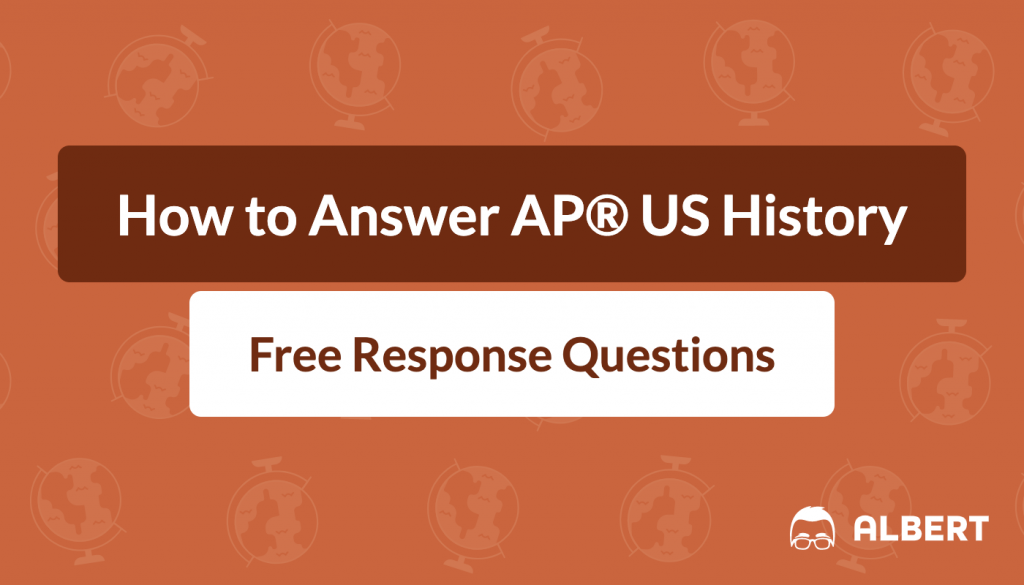
Knowing how to answer AP® US History Free Response Questions is an art. If you’re looking for the best tips and tricks for writing APUSH FRQs, you’ve come to the right place.
In this article, we’ll review a five-step strategy to writing top-mark AP® US History free response answers, mistakes students often make on the APUSH FRQs, as well as go over a compiled set of tips and test taking tricks for you to incorporate into your responses.
Keep reading to get the scoop on what you need to know when it comes to maximizing your limited AP® US History exam review time.
What We Review
5 Steps on How to Write Effective AP® US History Free Responses
Here, we’ll review a five-step strategy for you to start writing AP® US History free response answers that will score you maximum possible points.
1. Master the three different rubrics for the AP® US History SAQ, DBQ, and LEQ.
The biggest mistake a student can make when it comes to preparing for AP® US History is never truly understanding how they’re going to be graded. This leads to scattered responses that do not provide the specificity that translates to points on the exam.
To solve this, you’ll want to go to the College Board’s AP® Central website and navigate to the previously released exams for APUSH:
Here is the link for AP® US History past released exams
Open up the scoring guidelines PDF. These guidelines outline how points were distributed on that particular year’s exams.
Here’s a screenshot from the first question of the 2019 released exam:
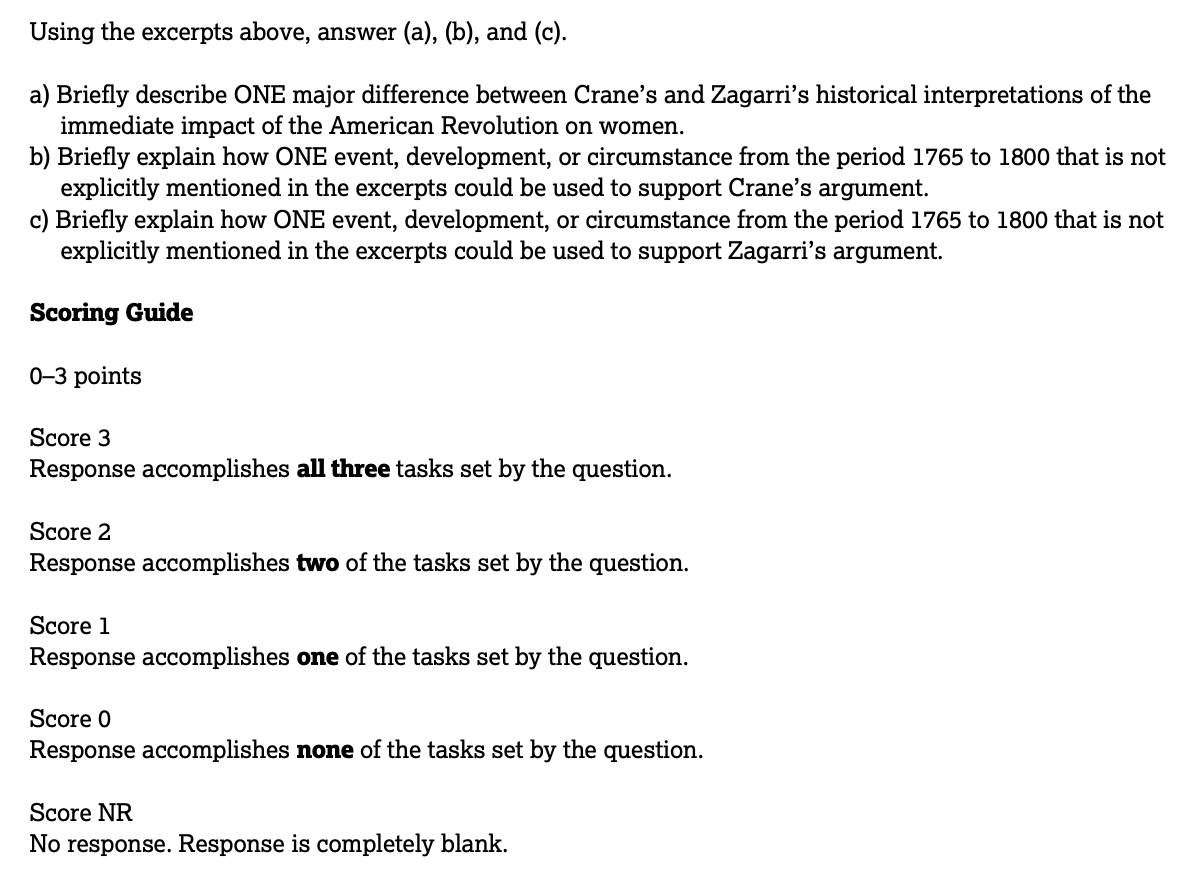
Source: College Board
From the above, you’d see that the first SAQ was worth three points, and each point was awarded for successfully completing the task asked within the question. After reviewing a few of these questions, you’d start to notice the level of specificity the graders require in order to earn points. For example here you can see that in order to adequately describe the differences between the two sources’ historical interpretations, students had to explicitly state the positions of both authors.
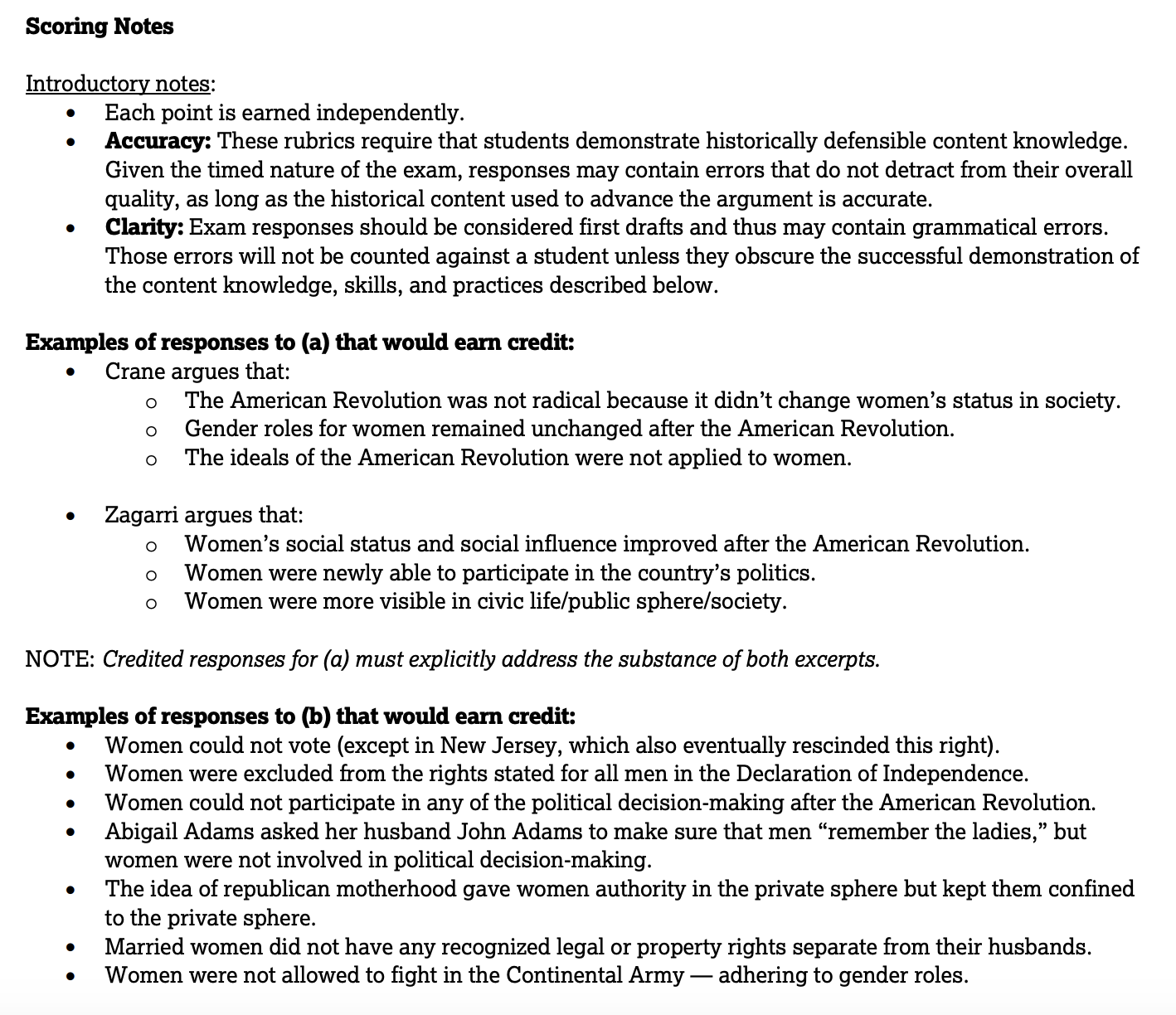
As you familiarize yourself with each type of question, you’ll start to notice the College Board always uses a predictable set of directive words in their questions. We’ll cover that later in this post.
For now, be sure to review the last two years worth of released exam scoring guidelines so you can begin to understand how SAQs, DBQs, and LEQs are scored.
2. Underline or circle every bolded and capitalized word in the question prompt.
Now that we know how points are broadly distributed, we need to have a test taking system when reading and preparing for our responses.

As you can see in the above, the first SAQ of the 2019 AP® US History exam was assessing students’ abilities to describe and explain. In the majority of SAQs, you’ll be asked to describe or explain a response to stimuli.
For DBQs and LEQs, you’ll be asked one of three essay types: compare, change and continuity over time, or causation. This is commonly phrased using the directive words, “evaluate the extent of…”.
It’s easy to circle or underline the key phrases that you’re being asked to respond to.
There are two “key phrases” to commit to memory when it comes to AP® US History short answer questions:
That’s it. If you review the last several years worth of released exams, these are the most commonly used directive words for the short answer question section of APUSH.
If you aren’t sure what these words are asking you for, keep reading.
When the exam asks you to describe something, you need to tell them about what they’re asking. This doesn’t mean you need to explain the “why” — it just means you need to talk about what the topic is and the characteristics of the topic being asked.
When you’re asked to explain something, this is where you need to show the “why”. You need to be able to give 3-5 sentences with an example in most cases to earn credit for these questions.
After you’ve identified the key directive words, make sure you take note on how many examples you need to provide in your response. Sometimes students go above and beyond in their response, but what they don’t realize is that if they give more than what was asked, the reader will move on after the student reaches what the question has asked (i.e. the question asks you to describe one thing and you state three; in this case, only the first is considered for your score).
One of our favorite test taking tips is to make a tick mark or star next to the words you’ve circled or underlined after you’ve answered it in your free response. This gives you a visual way to ensure you’ve answered all parts of the question.
It can be so easy to not answer the question that’s being asked of you.
Aside from describe and explain, here are other potential directive words the College Board may give you for AP® US History:
- Compare : Talk about similarities and/or differences.
- Evaluate : Determine how important information or the quality/accuracy of a claim is.
- Identify : Give information about a specific topic, without elaboration or explanation.
- Support an argument : Give specific examples and explain how they support a thesis.
3. Plan your response BEFORE beginning to write your response.

When the College Board shared their favorite AP® US History exam tips , they put this at the very top of their considerations. They describe that it’s common for students begin writing responses immediately and as a result, students create poorly planned responses that are disconnected.
Remember, the FRQ is intended to test your ability to connect the dots of what you’ve learned in class to historical thinking skills. The crucial skill is being able to identify evidence, and connect it to a historically defensible thesis as part of your historical analysis.
To do so elegantly, you must plan out your response before you begin writing.
Here’s what we suggest: read the question once to circle the directive words. Then read it a second time to ensure your understanding of what’s being asked. If needed, read the question a third time and think about how you’d word the question in your own words.
Craft a clear thesis statement. An easy way to do so is with the “although A, XYZ, therefore” model. We go over this in our tips section below. Ask yourself, is my thesis defensible? Can I agree or disagree with it?
Then, think about what evidence you can bring in to respond to the question — how does this evidence connect back to your thesis? Do not leave it to your reader to infer what you mean when you include certain supporting evidence.
This process will help you start to think through what you’re actually answering and how you’ll answer the “why” based questions. It’ll also help you avoid simply restating the question without adding any direct response to the question (what is known as a historically defensible thesis or a thesis with a clear line of reasoning).
4. Remember that AP® US History DBQs and LEQs require you to demonstrate four key skills: formation of a thesis, contextualization, sourcing, and complexity. SAQs should directly respond to what’s being asked.
For short answer questions in AP® US History, you do not need to write an essay to score all the possible points. There is no need for an introduction, thesis, or conclusion on these questions.
For the DBQ and LEQs, scoring is clearly outlined on a respective seven and six point scale.
For the DBQ, you need to be able to:
- State a defensible claim or thesis that responds to the prompt and establishes a clear line of reasoning.
- Contextualize your response in the broader historical context (for APUSH, it’s typically demonstrating knowledge of the last 50-100 years prior to the time period asked in the prompt).
- You earn one point for using content from at least three documents to address the prompt and two points for using six documents as well as supporting an argument in response to the prompt.
- You earn an additional point for bringing in at least one piece of outside specific historical evidence beyond what has been provided.
- For analysis, students must source at least three documents discussing the author’s point of view, purpose, historical situation, and/or audience in relation to the thesis as well as illustrate a complex understanding of historical development to incorporate nuance into their response.
What this means is that as long as you cover all the points outlined above clearly, you can score a perfect score on the AP® US History DBQ.
For the LEQ, much is the same in the core rubric in terms of needing a thesis, providing contextualization, and analysis. For evidence, there is not a requirement for additional evidence beyond what is provided since that’s the entire point of the evidence section in crafting a long answer question response.
When you’re going through your mental checklist of whether you’ve demonstrated these skills, ask yourself if you’ve “closed the loop”. This is a test taking strategy the College Board promotes across multiple disciplines and with good reason — it challenges a student to demonstrate they can form a coherent argument. Closing the loop in AP® US History can mean using words like “because” or “therefore” to help bridge two concepts together and solve for the “why” this matters.
5. Practice, practice, and then practice some more.
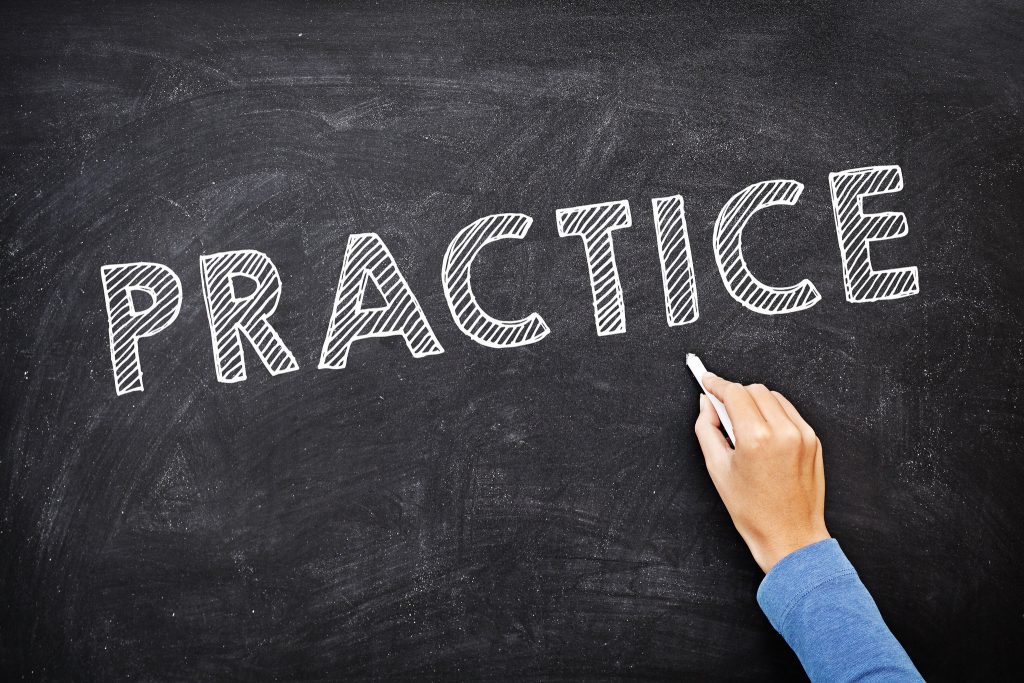
The nice thing about AP® free response sections is that they’re generally pretty predictable to prepare for. Ultimately they come down to knowing how you’re going to be assessed, and learning how to craft responses that match those criteria.
When you start preparing, try a set of released questions and then have your friend grade your responses with the scoring guidelines. See how you might have done without any intentional practice.
Then, review your mistakes, log them in your study journal and begin to tackle the areas where you’re weakest. Typically students struggle most with the evidence and analysis sections of the APUSH exam.
After a few times of doing this, you’ll have a stronger intuition towards the test and feel more confident heading into test day.
Return to the Table of Contents
37 AP® US History FRQ Tips to Scoring a 4 or 5
Now that we’ve gone over the 5-step process to writing good APUSH free responses, we can shift gears to tackle some test taking tips and tricks to maximizing your FRQ scores.
We recommend you review these several weeks, and then days before your exam to keep them top of mind.
15 AP® US History Short Answer Question Tips
- Answer the question.
- Cite your supporting evidence.
- Explain how your evidence proves your point.
- Focus much of your prep time on the E in ACE . Students often are not effective at earning the point for explaining because they simply restate a fact and fail to show how that fact supports comparison, causation, or continuity and change over time.
- Practice demonstrating comprehension of historical excerpts by working on sharing ideas from different sources in your own words. Review both primary and secondary sources.
- Practice supporting your main points of your thesis, and then practice supporting your minor points and details.
- Be specific in your responses to questions. It is not enough to say for example that “something changed”. What changed, how did it change and what might have prompted that change?
- One of the easiest ways to bridge two concepts is to use words like “because” or “therefore” and then proceed to answer the “why this matters”. Always double check that your answer addresses the how and the why — this is a good gut check for whether or not you’ve been specific enough.
- To help you score points in demonstrating your historical reasoning skills, use words like whereas, in contrast to, or likewise when drawing comparisons.
- Think of short answer questions as pop quiz drills, rather than full essays. There is no need for having a thesis in each SAQ response.
- Stick to the right time period and review your chronology. Sometimes students bring in irrelevant information from outside the time period being asked in the SAQ. More recently this happened in 2019 where students brought in information about women’s history that was not relevant to the time period asked.
- When presented with a stimulus such as an image to interpret, be sure that your reference to key concepts from class ties back to that stimulus. For example, “this image demonstrates the historical concept of CONCEPT, which was DEFINITION. This can be seen by the DESCRIPTION OF HOW THE IMAGE RELATES to the CONCEPT.”.
- Pennsylvania and Maryland are not part of the New England colonies!
- Know your key definitions with specificity. For example, it’s not enough to only state that the New Deal and Great Society programs helped the economy. To earn points, you must distinguish how the New Deal focused on America’s economy after the Great Depression to combat unemployment while the Great Society focused on social supports via Medicare and Medicaid to support Americans.
- Review your wars and presidents before, during and after key wars. Students have often confused things between WWI and WWII or between the Korean and Vietnam wars.
- Do not use the outcomes of a government program to describe a difference. Just because one program for example was successful while another was not does not demonstrate that you’ve mastered the content knowledge.
- For example, just because a primary source demonstrates something about a particular group of people doesn’t mean it necessarily applies to that entire geographic region. There is often nuance, which is why we study history!
17 AP® US History Document Based Questions (DBQ) Tips
- X is your counterargument or counterpoint
- ABC are your strongest supporting points for your argument.
- And Y is your argument.
- If you don’t like the above formula, another common way to form a thesis is to use the word “because” — the claims you make after you state “because” will be your argument.
- Cover your contextualization point in the introduction of your essay. The easiest way to do this is to discuss what was happening 50-100 years before your prompt and its relation to your thesis.
- In document 1, XYZ
- In document 2, XYZ
- Be sure to have clear topic sentences that relate back to your thesis. This helps you avoid document listing without direction in your essay.
- It’s not enough to just describe the content of the documents.You need to relate what’s going on in the documents to your thesis. Students lose points here for failing to include clear arguments or claims in relation back to their thesis.
- XYZ, therefore ABC
- XYZ is the description of the document
- ABC is the implication and support of how what you described relates to your thesis.
- Many students struggle with author purpose and point of view. Practice articulating what you believe to be the intention of the authors of documents and connecting it back to your argument. Don’t just say “the author has this point of view”.
- Continuity and Change Over Time : You should include at least one “however” statement at the end of every body paragraph. Example: XYZ changed…; however, one continuity was ABC…”
- Compare/Contrast : You should include a similarity and difference at the end of every body paragraph: “XYZ similarities…however, one difference was ABC…”
- Cause/Effect: Have at least one therefore statement at the end of each body paragraph. “XYZ happened….therefore, ABC consequence of XYZ happening”
- Sourcing is earned when specificity and significance is included in discussing historical context, audience, purpose, or point of view. You don’t earn it by making general statements.
- When sourcing, you only need to use one of the skills for each document you source. Don’t feel the need to go over historical context, audience, purpose, and point of view for every single document you are trying to earn sourcing for.
- Source at least four or five documents to be safe, in case you’re wrong in one of your interpretations.
- Be sure to incorporate a few examples of historical evidence from each decade from beyond the documents you’re given — this is worth a full point on your DBQ.
- When you incorporate outside evidence, make sure it’s from the same period you’re writing about. Chronology and time periods are important!
- It’s more than just including the word “however” to qualify an argument. It’s considering the broader picture and implications.
- It can also be demonstrated in the form of illustrating contradictions between documents or historical events in relation to the thesis.
- The College Board rubric describes this as “explaining relevant and insightful connections within and across periods”
- The College Board describes this as “explaining both similarity and difference”
- If you’re writing about causation, discuss the effects.
- If you want another way to earn this point, you can earn it by applying your argument to another time period and drawing a connection. If you do this, keep in mind you must apply your entire argument to another time period.
- A few possible stems to signal to your grader you are attempting complexity is to say use one of the following phrases: another time, another view, or another way.
5 AP® US History Long Essay Questions (LEQ) Tips
- Your thesis does not need to just be limited to the model of addressing economic, social and political issues. Students have often overused this format when they could be better off understanding core AP® US History themes and how they relate to the question being asked.
- Make sure you know your time periods. Students often lose points when it comes to evidence because they bring in concepts that are outside the scope of the time period or region. Chronology is important across the entire AP® US History exam.
- Review the causes of key events and how the occurrence of key events impacted society over time. For example, what was fought for in women’s rights before Roe v. Wade, what led to it happening, and what were the outcomes from the case happening going forward in relation to women’s rights?
- Show the “why” of the evidence you’re providing. It’s not enough just to mention a concept. Explain to the reader why you are including that concept or evidence and relate it back to your thesis. Evidence should further your argument.
- If you’re answering a continuity and change over time question, make sure you also discuss continuity. Students often only talk about change over time.
Wrapping Things Up: How to Write AP® US History FRQs
Whoa! We’ve reviewed a ton of information in this AP® US History FRQ review guide. At this time, you should have an actionable 5-step plan for your FRQ prep as well a 37 test taking tips to prepare with.
Putting everything together, here are a few key things to remember:
- Students who excel on the AP® US History free response section do so because they understand how they’re being graded. Master the rubrics. Understand how and when points are awarded and not rewarded. There are tons of previously released exams to help you here.
- Follow a regular system for responding to each question. Whether it’s our approach of identifying the directive word, planning and then writing while checking off after you’ve answered each part of the prompt, have a methodology in the way you craft responses.
- Remember the ACE acronym for SAQs: answer the question, cite your evidence, and explain how your evidence proves your point.
- Focus your time on chronology, time periods and course themes. This will help you write within the scope of the time period given in each question and not lose points by mistakenly incorporating something outside of the time period being asked.
- Review commonly tested AP® US History topics. Review the curriculum and exam description to see the percentage breakdown of different units. Units 3 through 8 are always more important for the exam than Units 1-2, and 9.
- Make sure your thesis includes a clear line of reasoning. Remember the model: Although X, ABC, therefore Y.
- Always “close the loop”. Use words such as “because” or “therefore” to bridge two concepts together and solve for the “why” this matters.
We hope you’ve found this FRQ guide helpful for your AP® US History exam review.
If you’re looking for more free response questions or multiple choice questions, check out our website for more valuable exam prep! Albert has hundreds of original standards-aligned practice questions for you with detailed explanations to help you learn by doing.
If you found this post helpful, you may also like our AP® US History tips here or our AP® US History score calculator here .
We also have an AP® US History review guide here .
Interested in a school license?
Popular posts.

AP® Score Calculators
Simulate how different MCQ and FRQ scores translate into AP® scores

AP® Review Guides
The ultimate review guides for AP® subjects to help you plan and structure your prep.

Core Subject Review Guides
Review the most important topics in Physics and Algebra 1 .

SAT® Score Calculator
See how scores on each section impacts your overall SAT® score

ACT® Score Calculator
See how scores on each section impacts your overall ACT® score

Grammar Review Hub
Comprehensive review of grammar skills

AP® Posters
Download updated posters summarizing the main topics and structure for each AP® exam.
- Skip to Content
- Skip to Main Navigation
- Skip to Search

Indiana University Bloomington Indiana University Bloomington IU Bloomington

- Mission, Vision, and Inclusive Language Statement
- Locations & Hours
- Undergraduate Employment
- Graduate Employment
- Frequently Asked Questions
- Newsletter Archive
- Support WTS
- Schedule an Appointment
- Online Tutoring
- Before your Appointment
- WTS Policies
- Group Tutoring
- Students Referred by Instructors
- Paid External Editing Services
- Writing Guides
- Scholarly Write-in
- Dissertation Writing Groups
- Journal Article Writing Groups
- Early Career Graduate Student Writing Workshop
- Workshops for Graduate Students
- Teaching Resources
- Syllabus Information
- Course-specific Tutoring
- Nominate a Peer Tutor
- Tutoring Feedback
- Schedule Appointment
- Campus Writing Program
Writing Tutorial Services
How to write a thesis statement, what is a thesis statement.
Almost all of us—even if we don’t do it consciously—look early in an essay for a one- or two-sentence condensation of the argument or analysis that is to follow. We refer to that condensation as a thesis statement.
Why Should Your Essay Contain a Thesis Statement?
- to test your ideas by distilling them into a sentence or two
- to better organize and develop your argument
- to provide your reader with a “guide” to your argument
In general, your thesis statement will accomplish these goals if you think of the thesis as the answer to the question your paper explores.
How Can You Write a Good Thesis Statement?
Here are some helpful hints to get you started. You can either scroll down or select a link to a specific topic.
How to Generate a Thesis Statement if the Topic is Assigned How to Generate a Thesis Statement if the Topic is not Assigned How to Tell a Strong Thesis Statement from a Weak One
How to Generate a Thesis Statement if the Topic is Assigned
Almost all assignments, no matter how complicated, can be reduced to a single question. Your first step, then, is to distill the assignment into a specific question. For example, if your assignment is, “Write a report to the local school board explaining the potential benefits of using computers in a fourth-grade class,” turn the request into a question like, “What are the potential benefits of using computers in a fourth-grade class?” After you’ve chosen the question your essay will answer, compose one or two complete sentences answering that question.
Q: “What are the potential benefits of using computers in a fourth-grade class?” A: “The potential benefits of using computers in a fourth-grade class are . . .”
A: “Using computers in a fourth-grade class promises to improve . . .”
The answer to the question is the thesis statement for the essay.
[ Back to top ]
How to Generate a Thesis Statement if the Topic is not Assigned
Even if your assignment doesn’t ask a specific question, your thesis statement still needs to answer a question about the issue you’d like to explore. In this situation, your job is to figure out what question you’d like to write about.
A good thesis statement will usually include the following four attributes:
- take on a subject upon which reasonable people could disagree
- deal with a subject that can be adequately treated given the nature of the assignment
- express one main idea
- assert your conclusions about a subject
Let’s see how to generate a thesis statement for a social policy paper.
Brainstorm the topic . Let’s say that your class focuses upon the problems posed by changes in the dietary habits of Americans. You find that you are interested in the amount of sugar Americans consume.
You start out with a thesis statement like this:
Sugar consumption.
This fragment isn’t a thesis statement. Instead, it simply indicates a general subject. Furthermore, your reader doesn’t know what you want to say about sugar consumption.
Narrow the topic . Your readings about the topic, however, have led you to the conclusion that elementary school children are consuming far more sugar than is healthy.
You change your thesis to look like this:
Reducing sugar consumption by elementary school children.
This fragment not only announces your subject, but it focuses on one segment of the population: elementary school children. Furthermore, it raises a subject upon which reasonable people could disagree, because while most people might agree that children consume more sugar than they used to, not everyone would agree on what should be done or who should do it. You should note that this fragment is not a thesis statement because your reader doesn’t know your conclusions on the topic.
Take a position on the topic. After reflecting on the topic a little while longer, you decide that what you really want to say about this topic is that something should be done to reduce the amount of sugar these children consume.
You revise your thesis statement to look like this:
More attention should be paid to the food and beverage choices available to elementary school children.
This statement asserts your position, but the terms more attention and food and beverage choices are vague.
Use specific language . You decide to explain what you mean about food and beverage choices , so you write:
Experts estimate that half of elementary school children consume nine times the recommended daily allowance of sugar.
This statement is specific, but it isn’t a thesis. It merely reports a statistic instead of making an assertion.
Make an assertion based on clearly stated support. You finally revise your thesis statement one more time to look like this:
Because half of all American elementary school children consume nine times the recommended daily allowance of sugar, schools should be required to replace the beverages in soda machines with healthy alternatives.
Notice how the thesis answers the question, “What should be done to reduce sugar consumption by children, and who should do it?” When you started thinking about the paper, you may not have had a specific question in mind, but as you became more involved in the topic, your ideas became more specific. Your thesis changed to reflect your new insights.
How to Tell a Strong Thesis Statement from a Weak One
1. a strong thesis statement takes some sort of stand..
Remember that your thesis needs to show your conclusions about a subject. For example, if you are writing a paper for a class on fitness, you might be asked to choose a popular weight-loss product to evaluate. Here are two thesis statements:
There are some negative and positive aspects to the Banana Herb Tea Supplement.
This is a weak thesis statement. First, it fails to take a stand. Second, the phrase negative and positive aspects is vague.
Because Banana Herb Tea Supplement promotes rapid weight loss that results in the loss of muscle and lean body mass, it poses a potential danger to customers.
This is a strong thesis because it takes a stand, and because it's specific.
2. A strong thesis statement justifies discussion.
Your thesis should indicate the point of the discussion. If your assignment is to write a paper on kinship systems, using your own family as an example, you might come up with either of these two thesis statements:
My family is an extended family.
This is a weak thesis because it merely states an observation. Your reader won’t be able to tell the point of the statement, and will probably stop reading.
While most American families would view consanguineal marriage as a threat to the nuclear family structure, many Iranian families, like my own, believe that these marriages help reinforce kinship ties in an extended family.
This is a strong thesis because it shows how your experience contradicts a widely-accepted view. A good strategy for creating a strong thesis is to show that the topic is controversial. Readers will be interested in reading the rest of the essay to see how you support your point.
3. A strong thesis statement expresses one main idea.
Readers need to be able to see that your paper has one main point. If your thesis statement expresses more than one idea, then you might confuse your readers about the subject of your paper. For example:
Companies need to exploit the marketing potential of the Internet, and Web pages can provide both advertising and customer support.
This is a weak thesis statement because the reader can’t decide whether the paper is about marketing on the Internet or Web pages. To revise the thesis, the relationship between the two ideas needs to become more clear. One way to revise the thesis would be to write:
Because the Internet is filled with tremendous marketing potential, companies should exploit this potential by using Web pages that offer both advertising and customer support.
This is a strong thesis because it shows that the two ideas are related. Hint: a great many clear and engaging thesis statements contain words like because , since , so , although , unless , and however .
4. A strong thesis statement is specific.
A thesis statement should show exactly what your paper will be about, and will help you keep your paper to a manageable topic. For example, if you're writing a seven-to-ten page paper on hunger, you might say:
World hunger has many causes and effects.
This is a weak thesis statement for two major reasons. First, world hunger can’t be discussed thoroughly in seven to ten pages. Second, many causes and effects is vague. You should be able to identify specific causes and effects. A revised thesis might look like this:
Hunger persists in Glandelinia because jobs are scarce and farming in the infertile soil is rarely profitable.
This is a strong thesis statement because it narrows the subject to a more specific and manageable topic, and it also identifies the specific causes for the existence of hunger.
Produced by Writing Tutorial Services, Indiana University, Bloomington, IN
Writing Tutorial Services social media channels

IMAGES
VIDEO
COMMENTS
Here's how the two-sentence formula can be applied to various 'extent to which' prompts: Prompt #1: Evaluate the extent to which the lives of women changed economically in the period from 1875 to 1910. The First Sentence of the Thesis: "To a great extent, the lives of women changed economically in the period from 1875 to 1910."
The thesis is normally one or two sentences in length. It's very natural to split the thesis into two sentences with the "line of reasoning" in the second sentence. There is no perfect length or word count for the thesis. What ... evidence, you can still earn the thesis point. AP ...
If you're taking AP World History or AP United States History and feel unsure about how to approach the DBQ thesis, you've come to the right place! In this post, you'll learn about a DBQ thesis formula that you can use to: A) consistently earn the thesis point and
2. The AP Readers need to be able to see that your essay has one main point. 3. Your thesis statement should indicate exactly what your essay is about, and help keep you on track A thesis statement in APUSH is the position a student is going to take, the argument that is going to be made. It is therefore the answer to the question being asked.
Nothing is more important in the first paragraph than the clear statement of an analytical thesis. The reader is most interested in seeing a strong thesis as soon as possible. Your thesis can be more than just one sentence. With the compound questions often asked by the DBQ, two sentences might be needed to complete the idea.
The thesis statement of an AP History essay is the most critical element of the essay. It will be establishing the basis of the entire paper, and if done properly will outline a comprehensive well-thought out essay. For this reason, a lot of planning needs to be done for the thesis statement as your examples and phrasing could be the key to a ...
Thesis Writing. Thesis= the main idea of the essay. What are you trying to prove? Thesis: a. fully address the prompt as many AP prompts will have more than one issue to be addressed; make sure you address all aspects of the prompt. b. should be one or two sentences (semi-colons are your friend) located at the end of your introductory paragraph ...
The thesis is normally one or two sentences in length. It's very natural to split the thesis into two sentences with the "line of reasoning" in the second ... evidence, you can still earn the thesis point. AP® U.S. History Study Guide: How to Earn a Thesis Point Notes: 2. Worksheet:
Focus on Writing a Solid Thesis. Your thesis is the most important part. It's going to set up the entire essay. It's also the first thing that the grader is going to see, so start with a strong thesis! Your introductory paragraph should be about 2-5 sentences in length. Start with a hook before including your thesis. Your thesis should be ...
The DBQ is the longer/more involved of the two essays for APUSH. You are given 60 minutes to write it, of which the first 15 are a planning/reading period. ... 3-4 sentences of context to explain background information and relate it directly to the topic of the prompt. 1-2 sentence thesis statement that restates prompt + provides an argument ...
I will take you through one DBQ on a prior APUSH exam and give you the ins and outs, and the dos and don'ts. ... The thesis must consist of one or more sentences located in one place, either in the introduction or the conclusion. ... but that student still got a point for their thesis. Example Thesis #2: The woman's rights movement was the ...
between 2 and 5 sentences, and it should clearly communicate your answer/stand and what you will be expounding upon in your body paragraphs. The Thesis Formula Options: Although X, Y because ABC. X. However A and B. Therefore, Y. 'X' represents the strongest point against your argument. We call this the counter-argument. It can
According to the College Board, the APUSH exam scoring notes state, "the thesis does not need to be a single sentence, it does need to be discrete, meaning it cannot be pieced together from across multiple places within the essay. It can be located in either the introduction or the conclusion, but not split between the two."
Use the documents and your knowledge of the years 1860-1877 to construct your response. This was the third DBQ we had written, and students were now getting brave enough to move beyond a thesis and document analysis and started attempting to tackle the contextualization point. However, the attempts were all over the map.
Because APUSH DBQs are open-ended, there are actually many different thesis statements you could come up with that would let you write an amazing answer. Here are two APUSH DBQ examples that College Board considers acceptable theses for this prompt: "The ideas about American independence changed greatly from 1763 to 1783.
2. Underline or circle every bolded and capitalized word in the question prompt. 3. Plan your response BEFORE beginning to write your response. 4. Remember that AP® US History DBQs and LEQs require you to demonstrate four key skills: formation of a thesis, contextualization, sourcing, and complexity.
Types of Thesis Statements: 1. Direct: This a straightforward statement that clearly and directly answers the question. To a remarkable degree Jacksonian democrats succeeded in implementing their vision of American society. 2. Compound: Use this approach when trying to prove two main points. Use the word "and.".
Step 2: Write your initial answer. After some initial research, you can formulate a tentative answer to this question. At this stage it can be simple, and it should guide the research process and writing process. The internet has had more of a positive than a negative effect on education.
APUSH: Contextualization and Writing an Introduction May 6, 2020. APUSH DBQ Practice: May 6, 2020 Objective/Learning Target: ... B. 1-2 Sentence Thesis Statement: Initially, colonial protests against the British government focused on unfair taxation, but as time went on, it became more about ...
The kind of thesis statement you write will depend on the type of paper you are writing. Here is how to write the different kinds of thesis statements: Argumentative Thesis Statement: Making a Claim. Analytical Thesis Statement: Analyzing an Issue. Expository Thesis Statement: Explaining a Topic.
This sentence provides more specific information and can serve as a basic outline for your paper. Based on the thesis statement, the body paragraphs for this paper will probably develop into three main points that explore the Roman, Greek, and Aztec religions. Thesis Placement Generally, the thesis sentence comes at the end of the introduction.
This is a strong thesis because it takes a stand, and because it's specific. 2. A strong thesis statement justifies discussion. Your thesis should indicate the point of the discussion. If your assignment is to write a paper on kinship systems, using your own family as an example, you might come up with either of these two thesis statements:
DBQ Structure. 1. Thesis. 2. Group docs in at least 3 different ways which help answer the prompt and these will be the body paragraphs+thesis points. When looking at the prompt look for. "action words" connect, impact, bridge, evaluate, compare and contrast. Each body paragraph requirements.
2. Using the image, respond to parts a, b, and c. Identify ONE likely political purpose of the image. Explain ONE way the image illustrates the economic situation of the period after the First World War. Explain ONE way the rise of the German National Socialist Party led to the Second World War. Question 3 or 4.